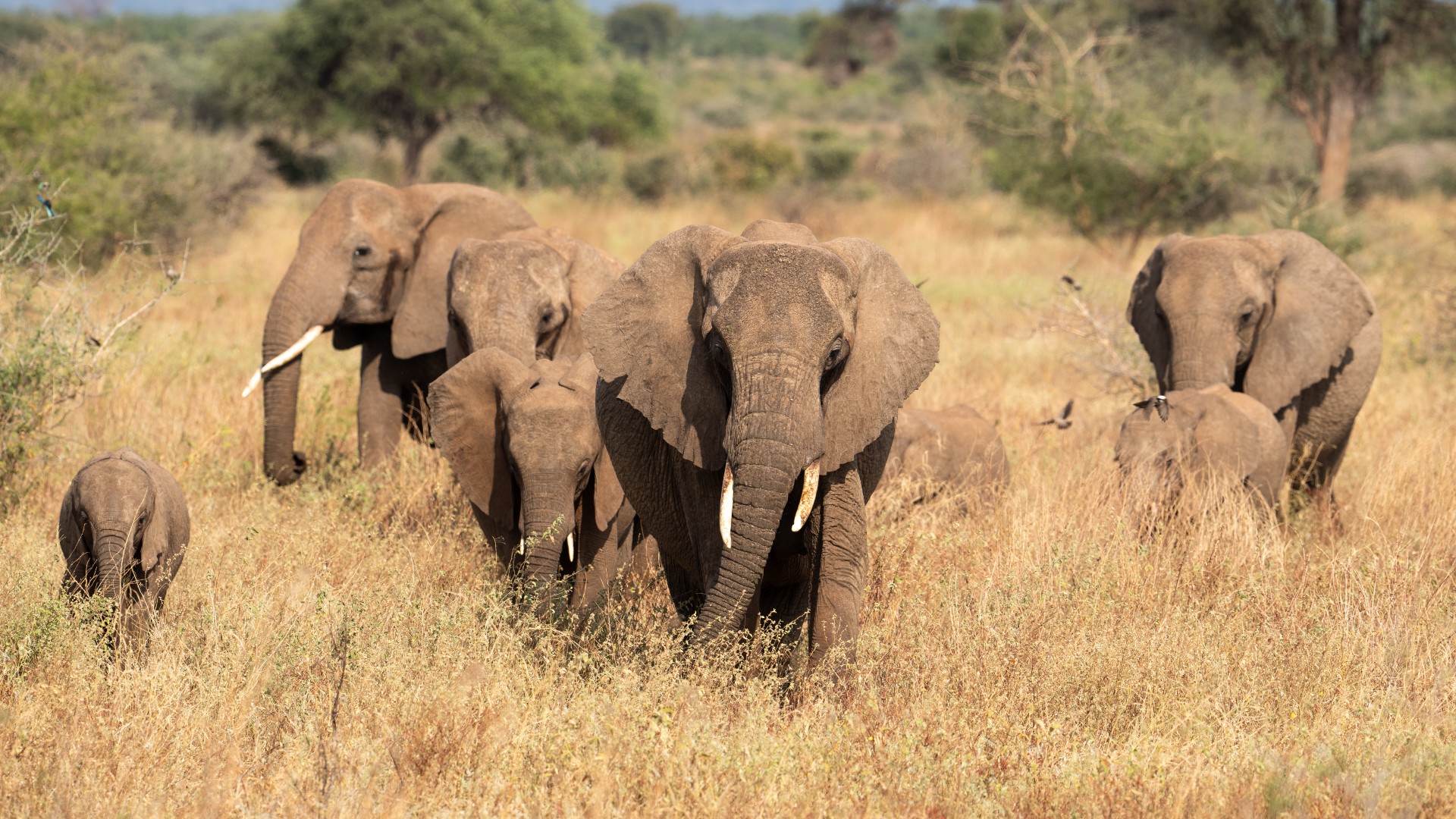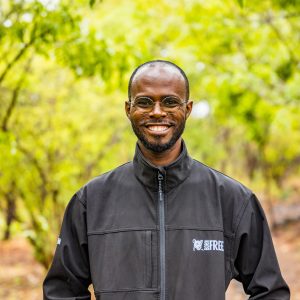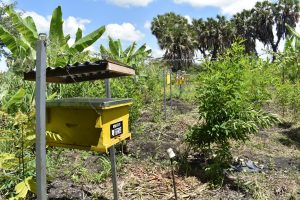In Conversation: Newton Simiyu, Saving Meru’s Giants
We recently spoke with Newton Simiyu, Programme Manager for our Saving Meru’s Giants programme, to discuss how Born Free is giving Hope for Elephants in the Meru Conservation Area, Kenya.

Wild elephants in Meru (c) Will Burrard-Lucas
How did you get into conservation?

Newton Simiyu, Saving Meru’s Giants
My passion for nature and wildlife started from a young age. I grew up in a rural area where I was lucky to encounter many different animals and plants. I was amazed by their variety and beauty and my dad’s passion for wildlife conservation was also a great influence. I chose to follow a career in conservation because I wanted to safeguard the natural resources and the wildlife that rely on them. Initially studying environmental resource conservation at university, before working for an environmental conservation organisation that focused on research, community, and livelihood, I later joined Born Free Kenya, a new chapter in my life, to protect wildlife and enable community co-existence. I have been working with Born Free Kenya for over seven years and I have witnessed my career development from a Project Officer to a Programme Manager and I am proud to be part of this wonderful team.
What does the role mean to you?
My role means a lot to me. It gives me an opportunity to make a positive difference in the lives of elephants and giraffes in Meru National Park, as well as the local communities that share the ecosystem with them. I am responsible for overseeing the implementation of various conservation activities, such as elephant monitoring, community engagement, education and awareness, and human-wildlife conflict mitigation. I also coordinate with other stakeholders, such as Kenya Wildlife Service, local authorities, and partner organisations, to ensure effective collaboration and synergy. I enjoy working with my colleagues and the community members who are passionate about conservation and co-existence.
What is the biggest challenge you face protecting elephants?
Human-elephant conflict is the biggest challenge we face in protecting elephants in Meru National Park. Elephants often wander outside the park boundaries in search of food and water, especially during the dry season. This brings them into conflict with farmers and pastoralists who see them as a threat to their crops and livestock. Elephants can be destructive, destroying fences, water pipes, and other infrastructure, foraging on entire fields of crops in a single night, and occasionally injuring or killing livestock and even humans. Elephants can cause significant economic losses and the risks and fear associated with elephants can strongly impact people’s wellbeing. In response, some people resort to killing or injuring elephants, using spears or by setting snares and traps in retaliation, resulting in injuries, such as snared limbs or broken tusks. We are working hard to minimize this conflict by implementing humane and effective deterrent measures like beehive fencing* in the affected communities, as well as educating local communities about the benefits of elephants to the ecosystem and the importance of co-existence.

A yellow beehive being used to create a fence to protect crops from elephants
What is your favourite part of your role?
My favourite part is the tracking and identifying of individual elephants in Meru National Park. I find it very rewarding and exciting to observe their behaviour, social structure, and personalities. Each elephant has a unique ear pattern, tusk shape, and body features that help us recognise them. We also give them names based on where we first sighted them or their distinctive characteristics. By knowing each elephant individually, we can monitor their health, movements, and population dynamics more accurately and effectively.
Are there supplies you are finding hard to get due to the global economic situation?
Yes, there are some supplies we are finding hard to get or more expensive due to the global economic situation, caused by the COVID-19 pandemic. For example, fuel prices have increased significantly in Kenya, affecting our transportation costs for field operations. Some equipment and materials that we need for our conservation activities, such as beehives and equipment and camera traps for monitoring beehive fences, have become extremely costly. We are trying to cope with these challenges by optimising our resources and prioritising our needs.
What are the biggest challenges in the upcoming months for you?
The rainy season (October-December) in Meru National Park is the biggest seasonal challenge that we are currently facing. The rain brings benefits, such as more vegetation and water for wildlife, but also challenges. The rain makes the roads and tracks in the park muddy and slippery, making it hard for us to access some areas and do our field work. We need to keep our vehicles and equipment in good condition and plan our routes carefully to avoid getting stuck or stranded. The rain also creates favourable conditions for the spread of diseases and parasites, such as anthrax, trypanosomiasis, and ticks, that can affect both wildlife and people. We need to monitor the health status of the elephants and other animals closely and report any signs of sickness or death to the veterinary authorities for quick intervention.
Then, in the new year, the dry season will begin. During the dry season, elephants tend to move closer to the park edges in search of food and water, where they interact with more people and their livelihoods. This raises the likelihood of crop raiding, and property damage by elephants, as well as retaliatory attacks by people. We need to increase our conflict mitigation measures, such as beehive fencing, and encourage the communities to adopt complimentary measures within our ‘conflict toolkit’ that can provide an early warning to farmers or prevent and resolve such incidents.
How does desnaring help elephants?
Snares are wire or rope loops that are set by poachers to catch animals for ‘bushmeat’ (meat from wild animals). Snares pose a risk to elephants and many other species including giraffes and lions, and can cause severe wounds, infections, or even death. Our Twiga** Team regularly patrols the national park, removing snares from ever harming an elephant or any other animal. They also are trained to remove snares safely if they discover an animal that has been caught, and they have rescued several lions from snares since the programme began. If we discover or receive reports of an elephant or any other animal caught in a snare, we immobilise it with a dart containing anaesthetic drugs, remove the snare from its body, treat the wound with antibiotics and antiseptics, and revive it with an antidote. We work closely with the Kenya Wildlife Service veterinarians and rangers to carry out snare removal successfully and safely. However, the best course of action is to prevent elephants getting caught in snares in the first place and our Twiga Team is dedicated to removing as many snares as they can from the park.
What is special about elephants?
Elephants are special animals for many reasons. They are the largest living land mammals on earth, the males weighing over six tonnes and measuring over three metres tall. They have a long dexterous trunk that serves as a nose, hand, arm, and hose, which they use breathing, smelling, drinking, feeding, touching, communicating, and manipulating objects. They have large ears that help them regulate their body temperature by flapping them to cool down or folding them to conserve heat. They have ivory tusks that grow throughout their lives and are used for digging, fighting, marking territory, and defending themselves. They have a complex social structure that is based on family bonds and friendships, living in groups called herds led by a matriarch – usually the oldest and most experienced female. They communicate with each other through vocalisations, gestures, touch, smell, and infrasound (low-frequency sounds that can travel long distances). They have a long memory that helps them remember places, routes, resources, individuals, events, and experiences. Elephants are highly intelligent, enabling them to solve problems, learn from others, show empathy, and express emotions. They even exhibit a rich culture that can be passed on from generation to generation through teaching, learning, and imitation. They have a spiritual dimension that is manifested in their rituals, ceremonies, and reverence for their ancestors. Elephants also play a vital role in maintaining the ecological balance of their habitats by dispersing seeds, creating waterholes, modifying vegetation, and influencing soil fertility.
What is your vision for the future of elephant conservation in Kenya?
To see a thriving population of elephants that co-exists peacefully with people in a healthy and secure environment. I hope we can reduce or eliminate the threats elephants face from human-wildlife conflict, habitat loss, poaching and climate change. I dream we can foster a culture of respect and appreciation for elephants among all Kenyans and beyond. I believe we can achieve this vision by working together with all stakeholders, such as government agencies, conservation organisations, local communities, the private sector, media, academia, donors, and tourists. I also believe we can learn from the elephants themselves, who are intelligent, social, and resilient animals that have adapted to changing circumstances over time.
YOU CAN HELP!
Please donate today to give Hope for Elephants. Your generosity really does make a difference!
* Elephants are scared of honey bees, so these deter elephants, protect crops, helps a farmer and provides income.
**Twiga is Swahili for ‘giraffe’
